Pistol Swords: How Gun Swords Were Fired

What’s in this article?
Throughout history, weapon makers attempted to produce combination weapons to provide a second line of defense. Sometimes called a gun sword, a pistol sword is a hybrid weapon that merges a firearm with a sword blade. They were attempts to create practical military weapons, though they often compromised the efficiency of both.
Let’s explore the different types of pistol swords, how each firing mechanism works, why some blade types are more efficient than others, and how they differ from bayonets.
Types of Pistol Swords
A pistol sword could be distinguished based on the firing mechanism or gunlock used to fire a projectile down the barrel of a gun. Early firearms used gunpowder and a ball inserted separately into the barrel. Early guns, unless multiple-barreled, could only fire one shot before reloading. So, armorers and gunmakers continued to experiment with better firing mechanisms.
1. Matchlock Gun Sword
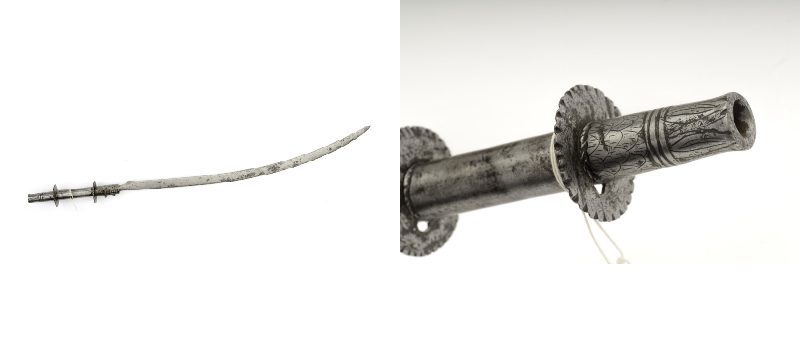
A matchlock was an early type of gun that used a slow-burning match or cord to provide ignition. The match was soaked in a chemical compound—potassium nitrate or saltpeter. On pulling the trigger, the match ignited the priming powder, which set off the main gunpowder charge in the barrel and fired the projectile, often a lead ball.
However, the early matchlock guns were often not pistols but muskets or large, heavy firearms. Matchlock muskets themselves were very clumsy weapons and not very accurate. They were unreliable in both wet weather and even in dry weather as the match was vulnerable to the effects of the wind.
Soldiers had to keep the match burning in readiness, even if no gun was fired. The slow-burning match cord also posed a risk to soldiers, as it could burn them and set off their supply of gunpowder. More than that, its glowing edge could reveal the soldier’s position to the enemy at night.
Mounted troops were unable to use matchlocks because the weapon needed two hands to operate, and they used their other hand to control their horses. Combination weapons of a matchlock gun and a sword are likely modern reconstructions and not historically used. Still, matchlock muskets remained in use in Europe even after the invention of other firing mechanisms.
2. Wheel Lock Pistol Sword

Far more reliable than the matchlock, the wheel lock was the first mechanical means of igniting a firearm. It used a metal wheel that rotated against a piece of iron pyrite to produce sparks, which lit the main gunpowder charge in the barrel. The wheel lock allowed guns to be carried, loaded, and ready for use.
Before the introduction of the wheel lock, pistols were rare, as soldiers could not pocket a matchlock that required live fire. However, the wheel lock pistol was expensive to manufacture and hard to repair, which posed problems in hunting and military situations. It likely resulted in the development of combination weapons, especially the pistol-sword or dagger-sword.
3. Flintlock Pistol Sword

Simpler and cheaper than the wheel lock, the flintlock utilized a piece of flint striking against a steel surface for ignition, which set off the main gunpowder charge. Flintlock weapons were most suitable for volley fire tactics, where soldiers fired their guns simultaneously. The flintlock musket appeared in the late 16th century and later became the primary infantry weapon in North America and Europe.
Unfortunately, wet weather dampened gunpowder, making it useless. Also, flintlock weapons had a poor rate of fire, about two or three rounds per minute, and soldiers were vulnerable to enemy attacks while loading them after firing. It likely led to the introduction of flintlock pistol swords, sometimes with a short sword or dagger blade that provided a second line of defense.
In the 18th century, German and French hunters likely utilized flintlock pistol swords for killing wounded wild boars. Apart from the delay in firing, the flash and smoke of the ignited powder gave time for birds and animals to escape. The flintlock mechanism also needed to be replaced after about 15 shots, as the steel surface also wore out, reducing its ability to create a spark.
4. Percussion Pistol Sword

The percussion mechanism used chemical ignition, which simplified the loading and firing process. It was also easier to use, more weatherproof, and less prone to misfire. Several armies adopted the percussion mechanism, converting older flintlock weapons to the new system. In the early 19th century, guns had a variety of percussion locks, though the percussion cap was the most efficient.
The percussion cap, named because of its shape, uses a metallic cap filled with explosives—mercury, potassium chlorate, and antimony. When struck, it bursts into flame, igniting the main gunpowder charge. In the 1850s, it paved the way for self-contained metal cartridges that are now used in modern firearms.
- U.S. Navy Elgin Cutlass Pistol
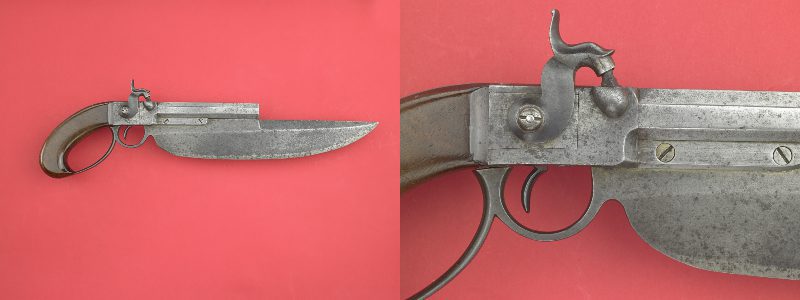
The U.S. Navy used the famous Elgin Cutlass Pistol, a combination percussion pistol and a knife blade, in the expedition to the South Sea. The Americans also used it against the Fijians in the Malolo Islands. It was a single-shot pistol and the only combination pistol weapon adopted by the U.S. military, though some found their way into civilian use.
5. Revolver Sword

The percussion mechanism also paved the way for repeating weapons, especially the revolver, a gun that carries ammunition in a rotating cylinder. In the 1840s, Samuel Colt manufactured single-action revolvers fired by percussion caps.
Eventually, self-contained metal cartridges—containing all the essential elements, such as explosives, charge, and projectile in one package—allowed guns to be reloaded easily. Revolvers also became part of combination weapons, with some attached to swords and sabres. The most popular designs are perhaps the revolver swords of August Rauh and R.J. Colvin.
Characteristics of a Pistol Sword
Pistol swords varied greatly in their quality, type of sword, size, and design, depending on their origin and owner’s preferences.
Here are the unique characteristics of a pistol sword:
Manufacture and Quality
The first gunsmiths were likely skilled craftsmen who honed their skills in making armor and edged weapons. Germany was known for their high-quality blades and was also the largest manufacturer of pistols and individual components. German wheel locks were heavily constructed and reflected the baroque style of the time.
In the 19th century, some European pistol swords were made in Belgium, especially revolver swords. Some inventors, such as August Rauh and Robert Colvin, also patented their revolver sword designs. The famous Elgin cutlass pistol of the U.S. Navy was made by C.B. Allen of Springfield and also Morrill, Mosman & Blair.
Type of Sword Blade
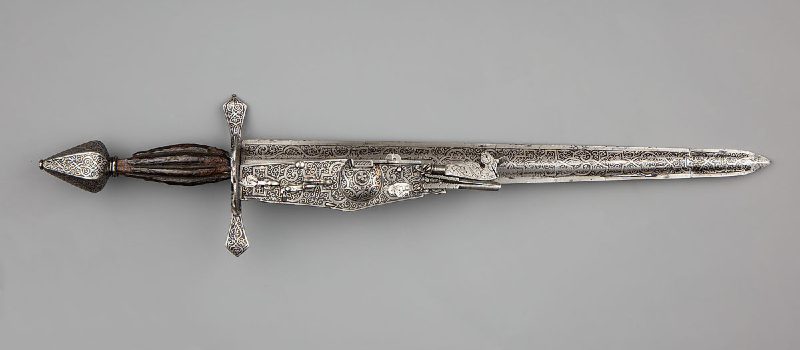
Pistol swords had varying blade types and shapes, from the typical straight blades to curved sabers. In the 16th century, wheel lock pistols were often combined with daggers and swords, which could serve as backup weapons. On the other hand, the famous U.S. Navy Elgin cutlass pistol had a Bowie Knife blade.
Gun Barrel and Blade
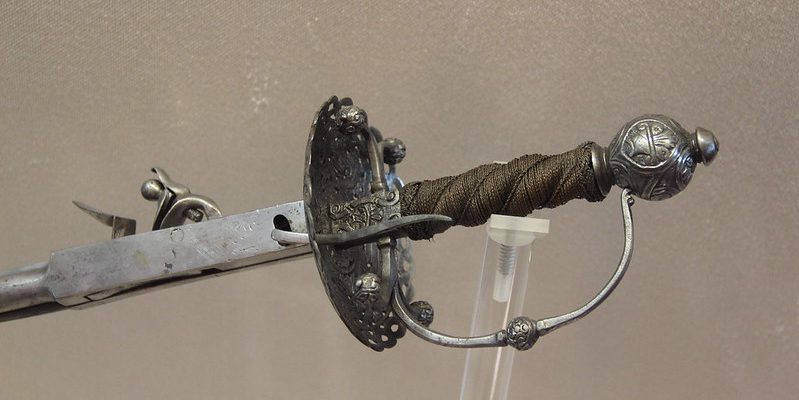
Pistol swords usually had gun barrels attached to the side of the blade, and the direction of fire was also toward the blade tip. Some examples also had the barrel on the upper portion of the blade while others had hollow blades serving as the gun barrel.
The earliest pistol swords were single-shot and compact, though there were also double-barreled designs, with one barrel on each side of the blade. German pistol swords in the late 16th century were highly decorated, often with etched decorations on both the blade and barrel.
Size and Length
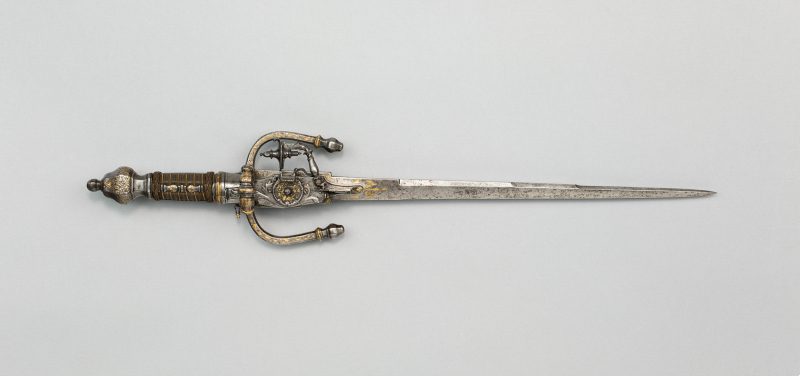
Pistol swords greatly varied in length from long swords to short swords, though pistol daggers and knives were the most popular. Some flintlock pistol swords had an overall length of 28 inches, with a 22-inch blade and 3-inch barrel.
The revolver sword of August Rauh is a cavalry saber with a blade length of 36 inches. Pistol swords also varied in caliber or the diameter of a cartridge. The U.S. Navy Elgin cutlass pistol had an overall length ranging from 13 to 17 inches and was a single-shot .54 caliber.
Gun Sword Mounting
The firing mechanism often sits near the hilt, though other pistol swords had gunlocks inside the grip.
Hilt
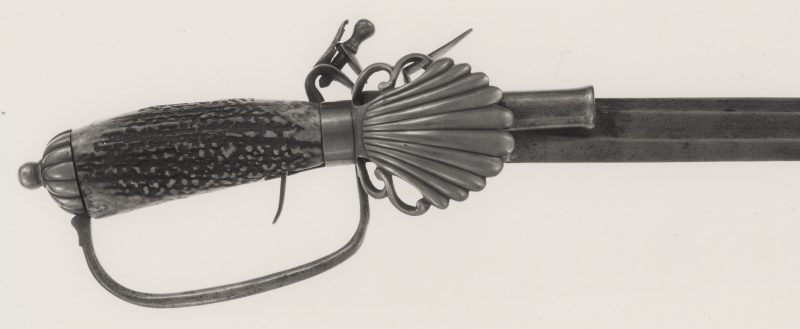
Some pistol swords had shell guards that protected the firing mechanism, and the trigger was at the front of the guard. Some designs also had the gun barrel forming the hilt and was therefore designed to fire backward, away from the blade tip.
Scabbard
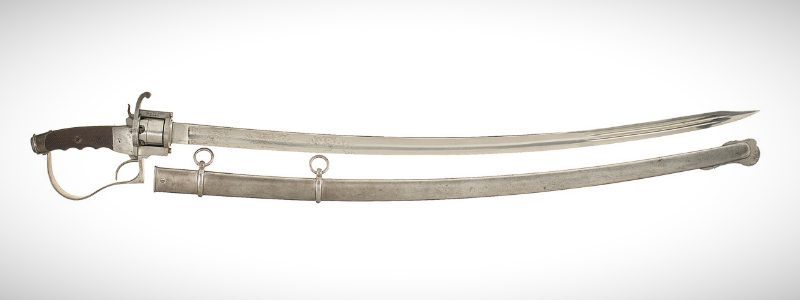
Some pistol swords had plain metal scabbards with suspension rings, like the typical military swords. Some scabbard constructions can be folded to serve as a shoulder stock, supporting the weapon and allowing better control on the firearm.
Pistol Swords vs. Bayonets
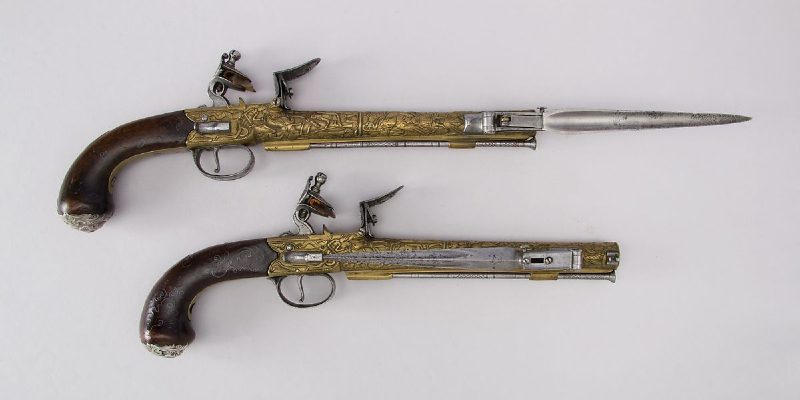
A pistol sword was designed primarily as a sword, and its handgun only functioned as a secondary weapon. On the contrary, pistols mounted with a bayonet—a blade fixed to the muzzle of the gun barrel—were designed primarily as a firearm. Still, the bayonet could serve as a stabbing weapon in close-quarters combat, especially when the pistol ran out of ammunition.
Some European officers used custom-made pistol swords, especially those with basket hilts. Most of the time, the components of a pistol sword are fixed and cannot be separated, unlike most pistols equipped with a bayonet. Some bayonets could be released by pulling back a trigger guard. However, pistols with a bayonet were more common than pistol swords.
In the early 19th century, many armies used a longer sword bayonet, which could be removed from the gun and utilized in close-quarters combat. The British Army also used the Pritchard-Greener bayonet, which was never a standard-issue weapon. However, the development of machine guns drastically reduced the efficiency of the bayonet.
Pistol Sword vs. Pistol Knife
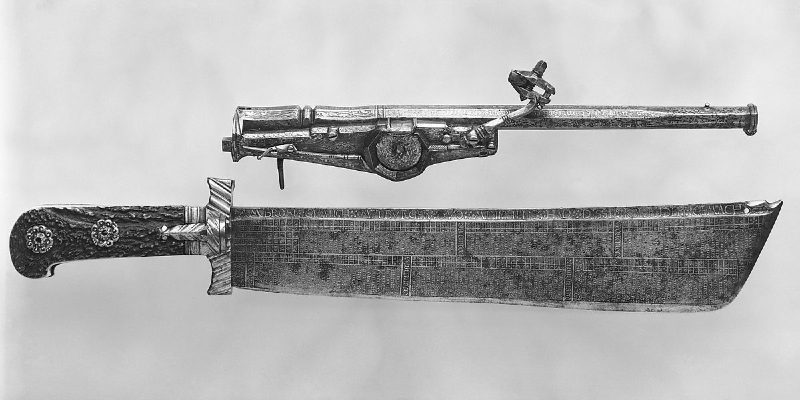
Pistol knives were more common than pistol swords, likely because of their compact sizes, making them more practical for hunters. Pistol knives were most popular in the 1830s because of the famed James Bowie.
However, like pistol swords, the U.S. Navy Elgin had an unwieldy Bowie knife blade, so the government did not extend the contract beyond the initial 150 pistols. During the Victorian era in England, the pistol knives of British sword-cutlers Unwin & Rodgers gained popularity as a self-defense weapon.
Was The Pistol Sword a Good Weapon?
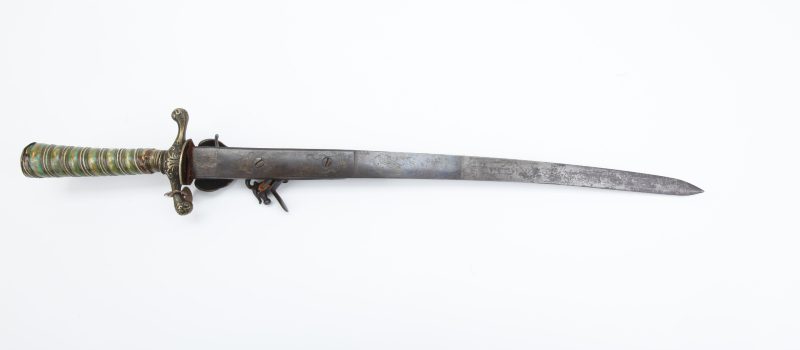
Combining a handgun and a sword blade to provide a second line of defense seemed like a practical innovation. However, pistol swords were impractical for military use, as the handgun made the sword poorly balanced and harder to wield. Also, the grip angle of the hilt made it harder to point and aim as a pistol.
The gun barrel, including the rotating cylinder on revolver swords, is at the front of the sword guard. It could easily be struck and deformed when parrying and cause the firearm to fail. Pistol swords varied in their triggers, though most had theirs on the right side of the sword grip, which is impractical for right-handed swordsmen.
Surviving examples with fully functional parts were likely produced for practical rather than ceremonial purposes. The U.S. government even issued pistol swords: the Swedish 1865 Cutlass Pistol to prison guards. However, pistol swords never gained much popularity and were not as widely used.
Modern reconstructions of pistol swords are often decorative and designed for collectors rather than fully-functional weapons. Today, pistol swords are commonly seen in pop culture as fictional weapons in anime, manga, and video games. The hybrid weapon appeared as the gunblade in the Final Fantasy video game and in Assassin’s Creed.
History of Combination Weapons
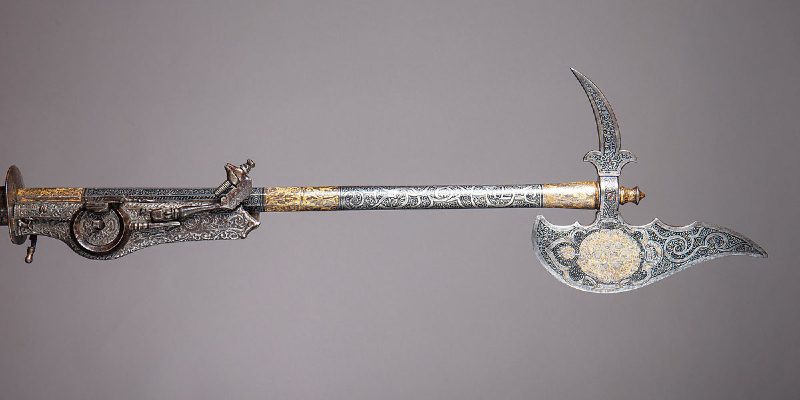
In the 16th century, the invention of the wheel lock led to the development of several combination weapons. Italian and German armorers incorporated firearms into various weapons for hunting and warfare, resulting in hybrid weapons like the pistol swords, battle ax pistols, war hammer pistols, halberd pistols, and crossbow pistols. In Italy, Ferdinand I, the grand duke of Tuscany owned an ax-pistol.
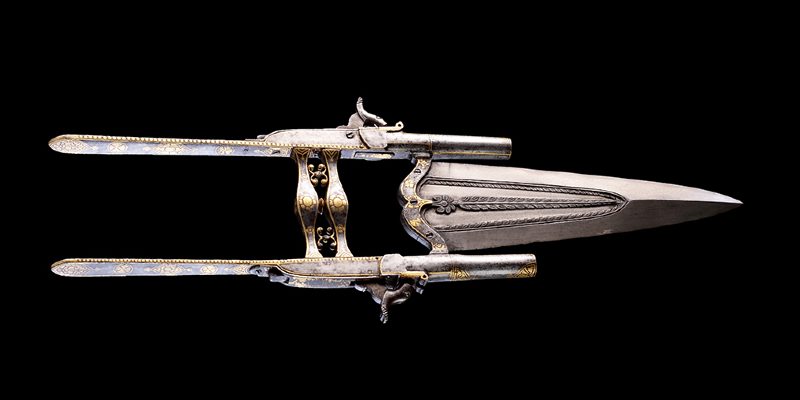
Similar weapons also included the pistol katar from India. Having functioned as a stabbing weapon, daggers were traditionally worn by Indian princes and nobles for hunting, display, and self-defense. It is normally gripped at the crossbars in a clenched fist, so the sidebars of the dagger are on the sides of the hand. Some 19th-century katar daggers featured built-in pistols on the sidebars and could be fired by squeezing the bars together.
Conclusion
Throughout history, weapon makers have tried to combine the benefits of more than one weapon. Pistol swords varied in their firing mechanism, from matchlock to wheel lock, flintlock, percussion, and revolvers, and were equipped with different types of blades. Today, they remain an object of interest for gun and sword collectors.




